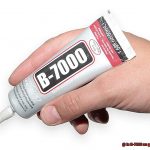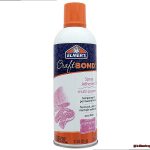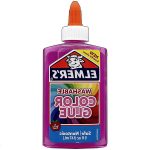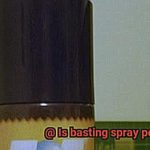Are you ever knee-deep in a project and find yourself desperately searching for the perfect adhesive to save the day? Look no further, my friends, because today we are delving headfirst into the fascinating world of barge cement and all its glorious effectiveness.
Barge cement, also known as contact adhesive, is like the superhero of bonding materials – leather, wood, rubber, metal – you name it, barge cement can handle it. But here’s the big question: does this stuff really live up to all the hype?
So, grab some popcorn (or maybe some glue sticks), kick back and let’s dive deep into whether barge cement is truly the real deal.
Benefits of Using Barge Cement
Contents
- 1 Benefits of Using Barge Cement
- 2 Types of Materials Suitable for Bonding with Barge Cement
- 3 Factors That Affect the Strength and Durability of Barge Cement Bonds
- 3.1 Surface Preparation: Laying the Foundation for Success
- 3.2 Material Compatibility: The Perfect Fusion
- 3.3 Application Technique: The Artistry of Precision
- 3.4 Curing Time: Patience Rewarded
- 3.5 Environmental Conditions: The Climate of Bonding
- 3.6 Age and Storage: Preserving the Fountain of Youth for Adhesives
- 4 Preparation and Application Guidelines for Optimal Results
- 5 Resistance to Heat, Water, and Chemicals
- 6 Advantages of Using Barge Cement in Various Industries
- 7 Disadvantages of Using Barge Cement
- 8 Alternatives to Barge Cement
- 9 Conclusion
In the world of adhesive solutions, one name stands out as a reliable and versatile option: Barge cement. This adhesive has gained the trust of professionals in industries such as shoemaking, upholstery, and leatherwork. In this article, we will explore the numerous benefits of using Barge cement, from its strong bonding properties to its flexibility and resistance to environmental conditions.
Strong Bonding Properties:
Barge cement is renowned for its ability to create a durable and long-lasting bond between different materials. Its versatility allows for seamless bonding between leather, rubber, fabric, and even plastic. Whether you’re working with porous or non-porous surfaces, Barge cement ensures a strong and secure connection. Say goodbye to weak adhesives that compromise the integrity of your projects.
Fast Drying Time:
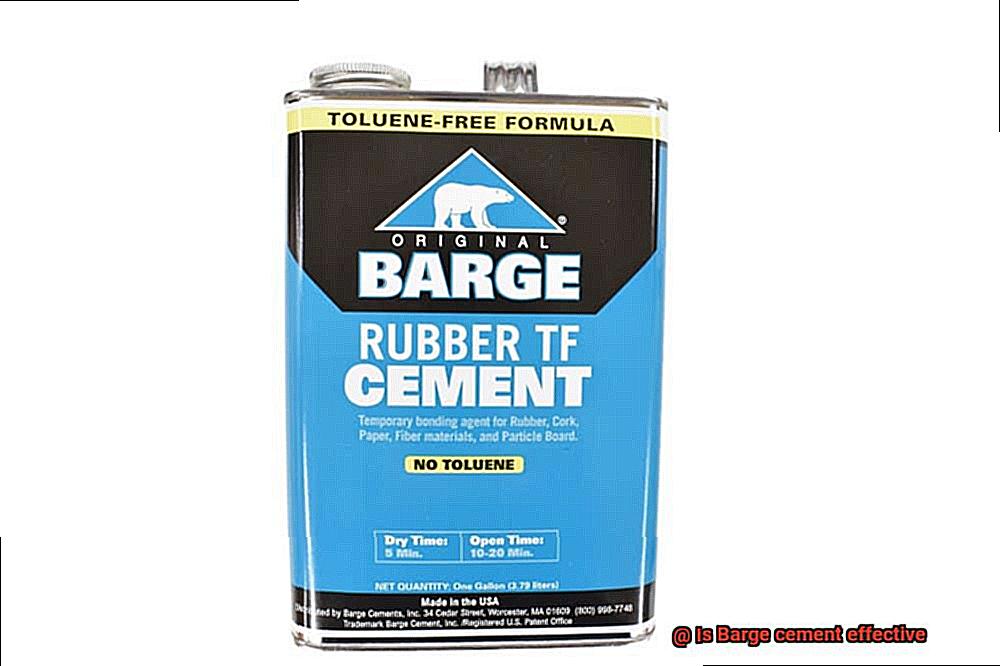
Time is precious in any project, and Barge cement understands that. Unlike other adhesives that require hours or days to dry completely, Barge cement typically dries within minutes. This speedy drying time enables efficient work processes, especially in time-sensitive projects where every second counts. With Barge cement, you can achieve more in less time.
Flexibility:
One of the standout advantages of using Barge cement is its flexibility. Once the adhesive has dried, it remains pliable and allows for movement and stretching of the bonded materials without compromising the bond. This flexibility ensures that your creations can withstand everyday wear and tear without losing their integrity. Your projects will be able to move with you.
Resistance to Environmental Conditions:
Barge cement is designed to withstand various environmental conditions. Its resistance to heat, moisture, and chemicals makes it suitable for both indoor and outdoor applications. Whether you’re creating a pair of shoes that need to endure rain or an outdoor upholstery project exposed to sunlight, Barge cement ensures a bond that can withstand all kinds of weather conditions. Your projects will remain intact, no matter what nature throws at them.
Versatility:
One of the key features of Barge cement is its versatility. It can be used on a wide range of materials, including leather, rubber, fabric, wood, metal, and plastic. This makes it a go-to adhesive for many different types of projects, eliminating the need for multiple adhesives and simplifying your toolkit. With Barge cement, you have the flexibility to tackle various projects with confidence.
Easy Application:
Applying Barge cement is a breeze. Whether you prefer the brush applicator or choose to use a roller or spatula, the adhesive spreads smoothly and evenly, providing proper coverage and bonding. Say goodbye to uneven application and hello to hassle-free adhesive application. With Barge cement, you can achieve professional results with ease.
Types of Materials Suitable for Bonding with Barge Cement
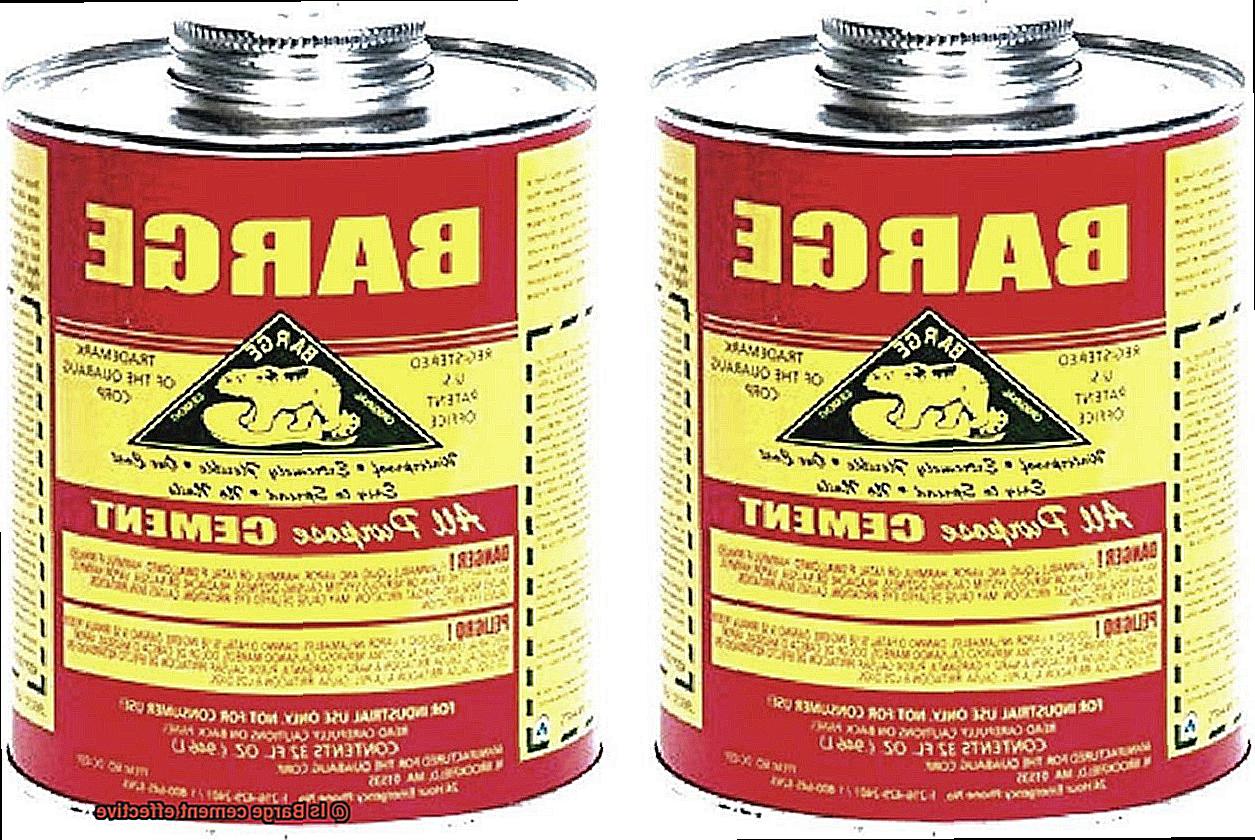
Prepare to embark on an adhesive adventure as we delve into the fascinating world of Barge cement. This incredible bonding agent has the power to bring materials together like magic. So, put on your goggles and get ready to explore the perfect matches for Barge cement.
Leather Love:
Barge cement and leather are a match made in adhesive heaven. With the grace of a superhero, Barge cement swoops in, penetrating leather’s pores to create a bond that could withstand a bull’s stampede. From repairing ripped shoes to attaching patches onto your favorite jacket, trust Barge cement to have your back when it comes to all things leather.
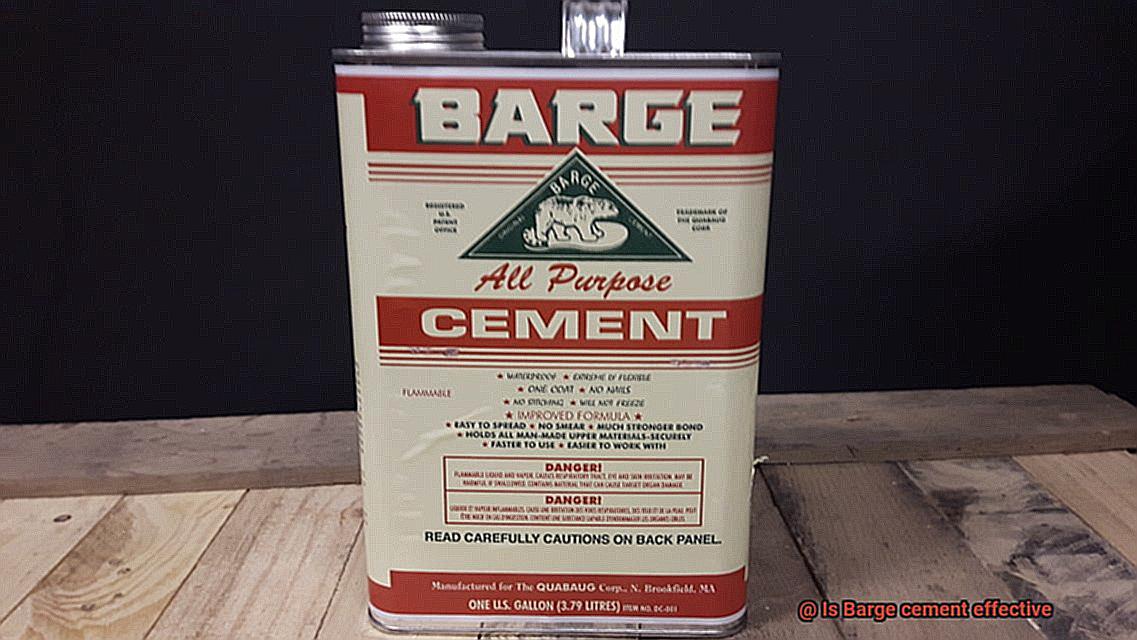
Rubber Rendezvous:
Rubber, rubber everywhere. Barge cement simply adores cozying up with rubber materials. Whether it’s shoe soles, rubber gaskets, or rubberized fabrics, Barge cement flexes its adhesive muscles and ensures those rubber buddies stay stuck together through all your adventures. With Barge cement, your rubber companions will be inseparable.
Fantastic Fabric:
Calling all seamstresses and crafters. Barge cement is here to save the day when it comes to fabric bonding. From hemming clothes to stitching fabric pieces together, Barge cement is your trusty sidekick. Just remember to test it on a small area before diving in headfirst, especially when dealing with delicate fabrics. Barge cement will keep your fabric creations intact and fabulous.
Wonderful Woodwork:
While not the star of the woodworking show, Barge cement can still play a valuable supporting role. Need to bond small wooden components or fix minor wood damage? Fear not, for Barge cement will lend a helping hand. However, for bigger woodworking projects, specialized wood glues might steal the spotlight.
Picky Plastic and Mighty Metal:
Now, let’s tackle the tricky territory of plastic and metal bonding. Barge cement can bond some plastics and metals, but not all. Some plastics and metals require specialized adhesives for a stronger connection. So, before you embark on your gluing adventure, double-check if your plastic or metal is compatible with Barge cement.
Factors That Affect the Strength and Durability of Barge Cement Bonds
Whether you’re an avid DIYer or a seasoned craftsman, understanding the essential factors that impact the performance of barge cement is crucial for achieving long-lasting results. So, let’s dive into the depths and uncover the secrets behind forging bonds that can withstand the test of time.
Surface Preparation: Laying the Foundation for Success
Before embarking on your bonding journey, meticulous surface preparation is paramount. Cleanliness reigns supreme. Rid your surfaces of any dirt, dust, oil, or grease that may impede the adhesive’s grip. A pristine and dry canvas ensures utmost contact between the cement and materials, giving rise to a bond that defies all odds.

Material Compatibility: The Perfect Fusion
In the world of barge cement bonding, compatibility is key. Just like finding a soulmate, it’s essential to ensure that the adhesive is harmonious with the specific materials at hand. Leather, rubber, wood, and select plastics often form a match made in adhesive heaven. Confirming compatibility guarantees a bond that transcends time.
Application Technique: The Artistry of Precision
Applying barge cement with finesse is vital for unlocking its true potential. Remember, less is more. A thin, even layer of cement applied on both surfaces paves the way for superior adhesion. Furthermore, exerting pressure or employing clamps during curing maximizes contact and fortifies bonds with unwavering strength.
Curing Time: Patience Rewarded

Just as masterpieces are not created overnight, strong bonds demand ample time to mature. Hasty approaches compromise both strength and endurance. Adhere to the manufacturer’s instructions regarding curing time to ensure a bond that boasts unwavering reliability.
Environmental Conditions: The Climate of Bonding
Like the ebb and flow of nature, barge cement bonds are influenced by their surroundings. Extreme temperatures and excessive humidity levels can impair the curing process and weaken adhesive performance. To achieve optimal results, adhere to recommended temperature and humidity ranges, cultivating an environment where bonds flourish.
Age and Storage: Preserving the Fountain of Youth for Adhesives
Just as time shapes all things, age matters for barge cement. Prior to use, verify the expiration date, as expired cement may yield weaker bonds. Proper storage in a cool, dry sanctuary ensures the adhesive’s longevity and preserves its potency.
Preparation and Application Guidelines for Optimal Results
Today, we’ll explore the essential steps for achieving optimal results when using Barge cement. Known for its strength and durability, this adhesive has the potential to create bonds that last. However, to unlock its full power, we must adhere to specific preparation and application guidelines.
First and foremost, surface preparation is paramount. Cleanliness is key – ensure that the surfaces you intend to bond are free from any dirt, grease, or oil. Take a mild detergent or solvent and give them a thorough scrub. Once they’re squeaky clean, allow them to dry completely before proceeding.
If you find yourself working with smooth or non-porous materials, a little roughening is in order. Grab some sandpaper or a roughening tool and create a textured surface that will provide better grip for the adhesive. This step is essential for maximizing bond strength.
Now it’s time to tackle the mixing and application process. Follow the manufacturer’s instructions closely regarding the recommended mixing ratio and technique. It’s crucial to achieve consistency throughout the adhesive by thoroughly mixing it.
Using either a brush or an applicator, apply a thin and even layer of Barge cement onto both surfaces. Remember, less is more – applying too much adhesive can actually weaken the bond rather than strengthen it.
Once applied, exercise patience and allow sufficient drying time before joining the surfaces together. Keep in mind that drying time can vary depending on factors such as temperature and humidity. For accurate recommendations, refer to the manufacturer’s instructions.
When the adhesive is dry to the touch, carefully align and join the surfaces together. Apply firm pressure evenly across the bonded area to ensure proper contact and adhesion. If needed, utilize clamps or weights to hold everything in place until the adhesive fully cures.
Lastly, grant ample time for proper curing. The duration can range from a few hours to several days, depending on various factors. Remember, rushing the curing process may compromise the bond strength, so exercise patience.
Resistance to Heat, Water, and Chemicals
Barge cement is the ultimate adhesive solution for those who need a bond that can withstand the toughest conditions. Whether you’re a DIY enthusiast or a professional in need of a reliable glue, Barge cement is the go-to choice for applications that involve exposure to heat, water, and chemicals. Let’s explore the remarkable world of this adhesive and discover why it’s a game-changer in the glue industry.
Heat Resistance:
Barge cement takes center stage when it comes to heat resistance. Its specially designed formulation can handle scorching temperatures without compromising its adhesive properties. From shoe repairs to securing automotive interior materials, Barge cement keeps your bond strong even in extreme heat.
Water Resistance:
Don’t let water dampen your projects. Barge cement boasts exceptional water resistance, making it perfect for outdoor applications or projects exposed to moisture. Whether you’re repairing inflatable boats or sealing seams on rain jackets, Barge cement can handle it all. Its hydrophobic components repel water, ensuring your bond remains intact even in wet conditions.
Chemical Resistance:
In industries where exposure to chemicals is the norm, Barge cement shines. Its formulation includes ingredients that allow it to resist the corrosive effects of various chemicals commonly encountered in automotive, construction, and manufacturing settings. Solvents, oils, and other chemical substances are no match for Barge cement. With this adhesive by your side, your bond won’t weaken or degrade due to chemical exposure.
Advantages of Using Barge Cement in Various Industries
Look no further than Barge cement, the adhesive that is revolutionizing industries across the board. With its strong bonding properties, Barge cement forms a bond that is so durable and long-lasting, you won’t have to worry about your materials coming apart. In the footwear industry, Barge cement is the secret ingredient that keeps shoe soles securely attached to the upper, preventing embarrassing moments of your sole separating from your shoe in the middle of the street.
But it doesn’t stop there – Barge cement also has a firm grip on the upholstery industry. It provides a secure bond between various fabrics, leathers, and foams, ensuring furniture that withstands the test of time. No more loose upholstery or worrying about your favorite chair falling apart.
And let’s not forget about automotive. Barge cement can handle it all when it comes to repairing or replacing your car’s interior. It effortlessly bonds different materials like vinyl, leather, and fabric, ensuring a seamless repair or replacement job. And with its resistance to heat and moisture, you won’t have to worry about your repairs coming undone in varying weather conditions.
Construction professionals also swear by Barge cement. Whether it’s wood, metal, concrete, or plastics, Barge cement has got you covered. Its strong adhesive properties make it the perfect choice for projects that require a reliable and long-lasting bond. No more worrying about your hard work falling apart.
But wait, there’s more. Barge cement isn’t just for professionals – it’s perfect for arts and crafts enthusiasts too. Whether you’re working with paper, fabric, wood, or plastic, Barge cement’s versatility allows for a wide range of creative projects. From scrapbooking to model building, the possibilities are endless.
So what sets Barge cement apart from other types of glue? First, its ease of application is unmatched. It comes in a convenient brush-on form, allowing for precise and controlled application. No more messy glue spills or uneven bonding – Barge cement ensures an even distribution for a strong and reliable bond every time.
And if you’re in a hurry, Barge cement has got your back. It has a quick drying time, meaning you can get on with your projects faster. No more waiting around for hours for your glue to dry – Barge cement gets the job done in no time.
Lastly, Barge cement is a superhero when it comes to resistance. It can handle the heat, moisture, and even chemicals that other adhesives can’t. This makes it the go-to choice for industries that require durability and reliability.
Disadvantages of Using Barge Cement
Although this adhesive is renowned for its strong bonding capabilities, it’s crucial to be aware of its downsides before diving into your next project.
Let’s address the elephant in the room – that pungent odor. Barge cement contains volatile organic compounds (VOCs) that emit a strong smell. This can be especially unpleasant if you’re working in a poorly ventilated area. Imagine trying to concentrate on your project while being overwhelmed by a noxious stench.
Next on our list is the drying time. Unlike some quick-drying adhesives, barge cement requires patience. It takes a significant amount of time to fully cure, which can be frustrating if you’re eager to use or handle your project immediately. Waiting can feel like watching paint dry, only stickier.
Another drawback is the residue and stains left behind by barge cement. This can be particularly troublesome when working with delicate materials or surfaces that need to maintain their pristine appearance. Picture spending hours meticulously crafting something, only to have unsightly marks ruin your masterpiece.
Removing barge cement can also prove challenging once it has dried and formed an unbreakable bond. Attempting to forcefully remove it may result in damage to the material it’s adhered to. It’s like trying to separate two fused objects without causing a catastrophic mess.
Speaking of materials, barge cement isn’t suitable for all surfaces. Plastics and fabrics with low melting points are a big no-no. Applying barge cement to these materials can cause discoloration, warping, or even melting. Imagine the horror of seeing your plastic project morph into a melted mess.
Lastly, let’s address the price tag. Barge cement can be on the pricier side compared to other adhesive options available. If you’re working on a tight budget, you might want to explore more affordable alternatives. After all, you don’t want to break the bank just to stick things together.
Now that we’ve explored some of the potential disadvantages of using barge cement, it’s important to weigh these drawbacks against the benefits for your specific application. Every project is unique, and it’s up to you to decide if barge cement is the right fit.
Alternatives to Barge Cement
Let’s embark on a journey through the world of adhesives and uncover some options that might just revolutionize your projects.
First and foremost, let’s talk about contact cement. This adhesive is an ideal choice for woodworking, laminate installation, and even automotive repairs. It creates a formidable bond when two surfaces are pressed together and comes in both solvent-based and water-based forms.
The solvent-based version dries rapidly, boasting impressive bond strength that makes it perfect for heavy-duty projects.
On the other hand, the water-based option is less toxic and provides a longer working time, allowing you to easily adjust your pieces before they become permanently fused.
If you’re seeking a versatile and durable glue, epoxy adhesive should be on your radar. This powerhouse adhesive consists of two components – resin and hardener – that must be mixed prior to application. Renowned for its exceptional strength, epoxy adhesive is capable of bonding a wide range of materials such as metal, plastic, wood, and ceramics. It truly shines in projects that demand a waterproof bond or require substantial strength.
For all you environmentally-conscious creators out there, water-based adhesives are a fantastic alternative to Barge cement. Crafted from natural ingredients or synthetic polymers, these glues are non-toxic, easy to use, and provide reliable bonding strength. They are perfect for an array of projects involving paper crafts, fabrics, or lightweight materials.
But let’s not forget about specialized adhesives designed specifically for certain materials or applications. Foam adhesive and upholstery glue exemplify this category. If you’re working with foam or upholstery projects, these adhesives are formulated to deliver a strong yet flexible bond tailored to those materials.
Keep in mind that the effectiveness of an adhesive can vary depending on the specific project and materials at hand. It’s always wise to conduct a small-scale test before committing to ensure compatibility and achieve desired results. Additionally, factors such as drying time, odor, toxicity, and ease of use should be taken into account when selecting the most suitable alternative for your needs.
Conclusion
In conclusion, Barge cement is undeniably effective.
Its strong adhesive properties make it a reliable choice for various bonding needs. Whether you’re working on leather projects, shoe repairs, or even DIY crafts, Barge cement delivers exceptional results.
Its quick-drying formula ensures that your projects stay intact and secure. With its long-lasting hold, you can trust Barge cement to withstand the test of time.
So why settle for anything less when you can rely on the proven effectiveness of Barge cement?


